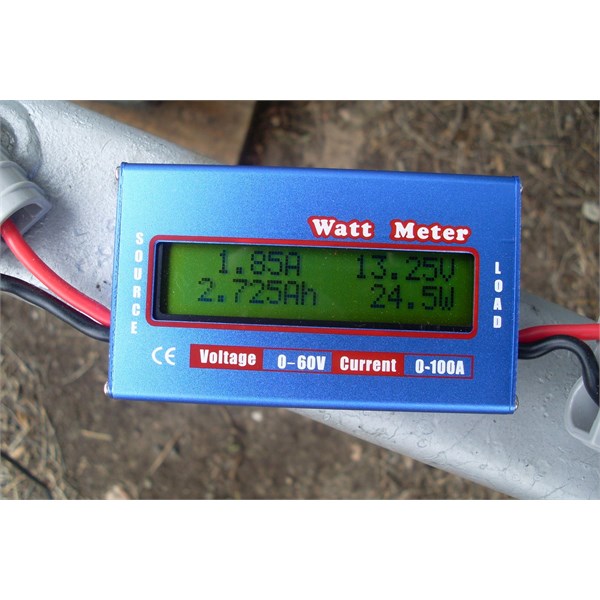How to read & understand a solar panel watt meter
Submitted: Saturday, Dec 06, 2014 at 12:07
ThreadID:
110349
Views:
8566
Replies:
2
FollowUps:
1
This Thread has been Archived
aussiedingo (River Rina)
G'day all,
for a first time setup & use of my new 220 watt portable solar panel I fitted an inline watt meter - now I need to know how to understand the readings - which is the most important one to monitor, also is this unit & the panels allowed to get wet?
wp, wa, ah, wh, etc ? thanks in advance.

watt meter readings
Reply By: Kelpie D - Saturday, Dec 06, 2014 at 14:10
Saturday, Dec 06, 2014 at 14:10
Yes, the panels can be left out in the rain. If you still have the controller attached to the panels,
check that it is weather proof, or make sure the panels are angled enough to keep it dry.
That just happens to be the exact same watt meter as
mine. I have just found that it was giving wrong figures. Good idea to double
check with a multi meter now and then.
The watt meter should not be allowed to get wet.
The display is explained in the instructions. Did you get an instruction sheet with it?
Everything with a P after it, means the maximum produced since connected. Example 4.88AP means the highest amps since connected is 4.88.
To re set the watt meter back to zero simply disconnect it at BOTH ends and plug it back in.
Going on the display in your
pic. Left of screen it is currently producing 1.85amps. Since connected it has produced 2.725 amp hours. That is your solar panel has produced it. The bottom number will rotate between all the measurements. The two figures shown in your
pic on the left are the important ones.
On the right it shows that 13.25 volts is going into the battery. Under that it shows 24.5 watts is going into the battery...1.85 amps at 13.25 volts = 24.5 watts. That is what is going into the battery not what is in the battery! To use the watt meter to
check actual battery voltage, disconnect the source end and leave the load (battery) end plugged in.
From what I have just been through over the past few weeks, I strongly suggest that you use the watt meter as a rough guide only. Use a multi meter to get your true measurements.
AnswerID:
542631
Reply By: Member - John and Val - Saturday, Dec 06, 2014 at 14:29
Saturday, Dec 06, 2014 at 14:29
Mmmmmh
where to start...... Suggest don't spend money unless you know what it's for! This time you've got something that may
well be useful, so here's what it does:
Your solar panel collects solar energy and converts it to electrical energy. This electrical energy is fed to your battery, fridge, etc. THROUGH this watt meter. The electrical force pushing this energy to these loads is the voltage - assuming the panel is connected to the "source" terminals and the battery, fridge etc to the "load" terminals, then the voltage at the battery here is shown as 13.25V. The flow of electric charge is measured in amps (A) and the meter here is showing a flow rate of 1.85 amps. The electrical energy flowing into the battery at a particular moment is measured in watts (W) which is the voltage multiplied by the amperage, here 13.25 x 1.85, = 24.5 watts.
We are more interested though, not in the flow of energy at a particular moment. It's much more useful to know the total energy collected in an hour or a day. When we are dealing with 12 volt systems we often come across amphours (Ah) which is a measure of average current flow (amps) multiplied by time. That 2.725 Ah figure tell me that if the current had been a constant 1.85 amps, then the meter must have been measuring it for about 1.5 hours.
So what's your meter for? It's checking on your battery voltage (V) which will vary from about 11.6 when very empty to 14.4 when being charged fast and close to full. It's checking on charge current (amps A), that's the rate of charging - depending on lots of factors you can expect to see up to 12 amps in strong sunlight with a battery that's
well discharged, down to almost zero when the battery is fully charged. The combination of voltage and current meters is something you'll come to rely on. In my opinion the other two meters, watts and amphours really don't contribute much - the state of your battery is determined by what's coming out as
well as what's going in. I think this unit only monitors what's going in.
What about getting wet? No problem for the panel, but I'd keep the meter dry.
Suggest you might find
Electricity for Camping a useful read.
Cheers
John | J and V
"Not everything that can be counted counts, and not everything that counts can be counted."
- Albert Einstein
Lifetime Member
My Profile My Blog Send Message |
AnswerID:
542632
Follow Up By: Allan B (Member, SunCoast) - Saturday, Dec 06, 2014 at 16:14
Saturday, Dec 06, 2014 at 16:14
Well Dingo,
John has certainly explained it
well...... even I can follow it! lol
If you have not already watched it, there is a video on
on this site covering what
John has said, that may be of further use to you.
John's
Electricity for Camping blog is also
well worth reading to gain a good understanding of generating and consuming 12v power in a camping situation.
FollowupID:
829064